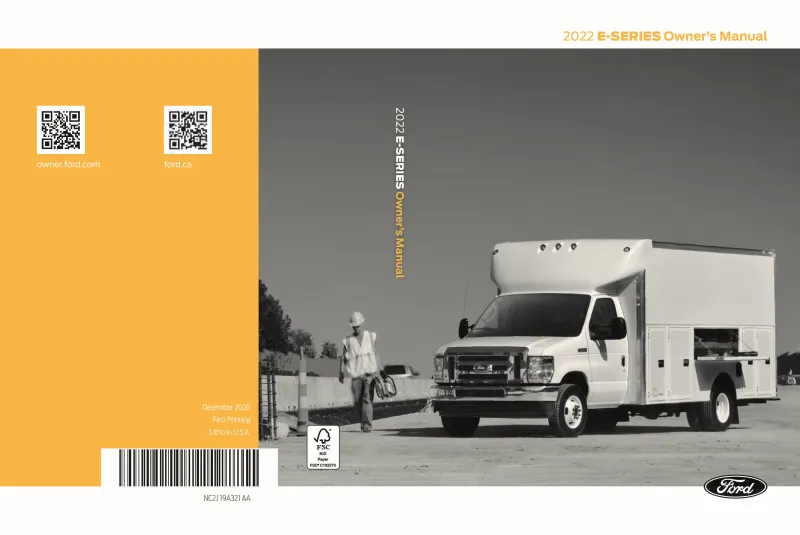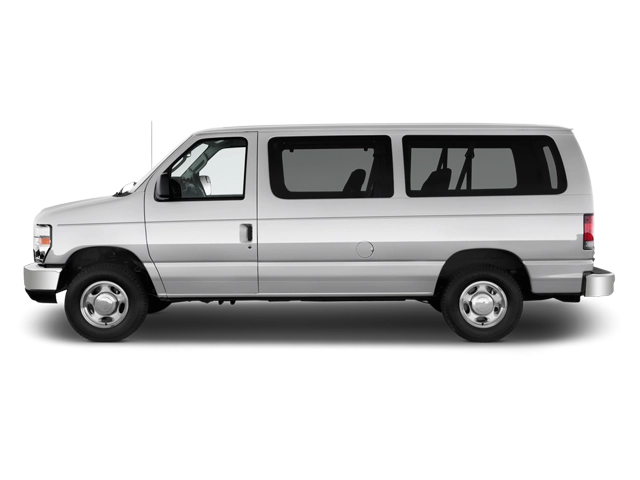2022 Ford E Series Owner's Manual

Year:
2022
Make:
Ford
Model:
E Series
Rating:
Table of Contents
Table of contents
4
Copyright ©
2
Introduction
10
About This Manual
10
Symbols Glossary
10
Data Recording
12
Perchlorate
16
Ford Credit
17
Replacement Parts Recommendation
17
Special Notices
17
Mobile Communications Equipment
19
Environment
20
Protecting the Environment
20
At a Glance
21
Instrument Panel
21
Child Safety
23
General Information
23
Installing Child Restraints
25
Booster Seats
29
Child Restraint Positioning
31
Seatbelts
33
Principle of Operation
33
Fastening the Seatbelts
34
Seatbelt Height Adjustment
36
Seatbelt Warning Lamp and Indicator Chime
36
Child Restraint and Seatbelt Maintenance
37
Seatbelt Extensions
37
Supplementary Restraints System
38
Principle of Operation
38
Driver and Passenger Airbags
39
Crash Sensors and Airbag Indicator
43
Airbag Disposal
44
Keys and Remote Controls
45
General Information on Radio Frequencies
45
Remote Control
45
Replacing a Lost Key or Remote Control
47
Doors and Locks
48
Locking and Unlocking
48
Security
51
Passive Anti-Theft System
51
Steering Wheel
52
Adjusting the Steering Wheel
52
Cruise Control - Vehicles With: Adaptive Cruise Control
52
Cruise Control - Vehicles With: Cruise Control
52
Information Display Control
53
Horn
53
Wipers and Washers
54
Windshield Wipers
54
Windshield Washers
54
Lighting
55
General Information
55
Lighting Control
55
Autolamps
56
Instrument Lighting Dimmer
56
Daytime Running Lamps
56
Direction Indicators
57
Automatic High Beam Control
58
What Is Automatic High Beam Control
58
Switching Automatic High Beam Control On and Off
58
Automatic High Beam Control Indicators
58
Overriding Automatic High Beam Control
58
Windows and Mirrors
60
Power Windows
60
Exterior Mirrors
60
Interior Mirror
61
Sun Visors
61
Instrument Cluster
62
Gauges
62
Warning Lamps and Indicators
65
Audible Warnings and Indicators
67
Information Displays
68
General Information
68
Information Messages
72
Climate Control
77
Manual Climate Control
77
Hints on Controlling the Interior Climate
78
Rear Passenger Climate Controls
79
Seats
80
Sitting in the Correct Position
80
Head Restraints
80
Manual Seats
81
Power Seats
82
Auxiliary Power Points
83
Auxiliary Power Points
83
Starting and Stopping the Engine
85
General Information
85
Ignition Switch
85
Starting a Gasoline Engine
85
Engine Block Heater
87
Fuel and Refueling
89
Safety Precautions
89
Fuel Quality - E85
89
Fuel Quality - Gasoline
91
Running Out of Fuel
91
Refueling
92
Fuel Consumption
93
Engine Emission Control
95
Emission Law
95
Catalytic Converter
96
Transmission
99
Automatic Transmission
99
Rear Axle
103
Limited Slip Differential
103
Brakes
104
General Information
104
Hints on Driving With Anti-Lock Brakes
105
Parking Brake
105
Hill Start Assist
106
Traction Control
107
Principle of Operation
107
Using Traction Control
107
Stability Control
108
Principle of Operation
108
Using Stability Control
109
Parking Aids
110
Rear View Camera
110
Cruise Control
112
What Is Cruise Control
112
Switching Cruise Control On and Off
112
Setting the Cruise Control Speed
112
Canceling the Set Speed
113
Resuming the Set Speed
113
Cruise Control Indicators
113
Using Adaptive Cruise Control
113
Driving Aids
121
Driver Alert
121
Lane Keeping System
122
Steering
125
Pre-Collision Assist
126
Load Carrying
130
Load Limit
130
Towing
135
Towing a Trailer
135
Recommended Towing Weights
136
Essential Towing Checks
137
Towing the Vehicle on Four Wheels
143
Driving Hints
144
Reduced Engine Performance
144
Economical Driving
144
Breaking-In
145
Driving Through Water
145
Floor Mats
145
Roadside Emergencies
147
Roadside Assistance
147
Hazard Flashers
148
Fuel Shutoff
148
Jump Starting the Vehicle
149
Transporting the Vehicle
150
Customer Assistance
152
Getting the Services You Need
152
In California (U.S. Only)
153
The Better Business Bureau (BBB) Auto Line Program (U.S. Only)
154
Getting Assistance Outside the U.S. and Canada
155
Ordering Additional Owner's Literature
156
Reporting Safety Defects (U.S. Only)
156
Reporting Safety Defects (Canada Only)
157
Fuses
158
Fuse Specification Chart
158
Changing a Fuse
166
Maintenance
168
General Information
168
Opening and Closing the Hood
168
Under Hood Overview
169
Engine Oil Dipstick
170
Engine Oil Check
170
Oil Change Indicator Reset
171
Changing the Engine Air Filter
171
Engine Coolant Check
172
Automatic Transmission Fluid Check
176
Brake Fluid Check
179
Power Steering Fluid Check
180
Changing the 12V Battery
180
Adjusting the Headlamps
182
Washer Fluid Check
183
Fuel Filter
183
Checking the Wiper Blades
183
Changing the Wiper Blades
183
Removing a Headlamp
184
Changing a Bulb
184
Vehicle Care
187
General Information
187
Cleaning Products
187
Cleaning the Exterior
188
Waxing
189
Cleaning the Engine
189
Cleaning the Windows and Wiper Blades
190
Cleaning the Interior
190
Cleaning the Instrument Panel and Instrument Cluster Lens
191
Cleaning Leather Seats
191
Repairing Minor Paint Damage
192
Cleaning the Wheels
192
Vehicle Storage
192
Wheels and Tires
195
General Information
195
Tire Care
196
Using Snow Chains
214
Tire Pressure Monitoring System
215
Changing a Road Wheel
220
Technical Specifications
224
Capacities and Specifications
226
Engine Specifications
226
Motorcraft Parts
226
Bulb Specification Chart
228
Engine Oil Capacity and Specification
229
Cooling System Capacity and Specification
230
Fuel Tank Capacity
231
Air Conditioning System Capacity and Specification
232
Washer Fluid Specification
232
Automatic Transmission Fluid Capacity and Specification
233
Brake Fluid Specification
234
Rear Axle Fluid Capacity and Specification
234
Hydraulic Power Steering Fluid Capacity and Specification
236
Vehicle Identification
237
Vehicle Identification Number
237
Connected Vehicle
238
Connected Vehicle Requirements
238
Connected Vehicle Limitations
238
Connecting the Vehicle to a Mobile Network
238
Connected Vehicle – Troubleshooting
238
Audio System
239
General Information
239
Audio Unit
239
Digital Radio
242
Connecting a Bluetooth® Device
244
Satellite Radio
245
Streaming Bluetooth Audio
247
Playing Media From a USB Device
247
USB Port
248
Using Voice Recognition
248
Accessories
249
Accessories
249
Auxiliary Switches
250
Ford Protect
252
Ford Protect
252
Scheduled Maintenance
254
General Maintenance Information
254
Normal Scheduled Maintenance
257
Special Operating Conditions Scheduled Maintenance
259
Customer Information
262
Radio Frequency Certification Labels
262
Appendices
266
Electromagnetic Compatibility
266
End User License Agreement
269
Index
292
Manual Questions
Do you have questions about the 2022 Ford E Series owners manual?
Fill the form below and someone will help you!
Fill the form below and someone will help you!
